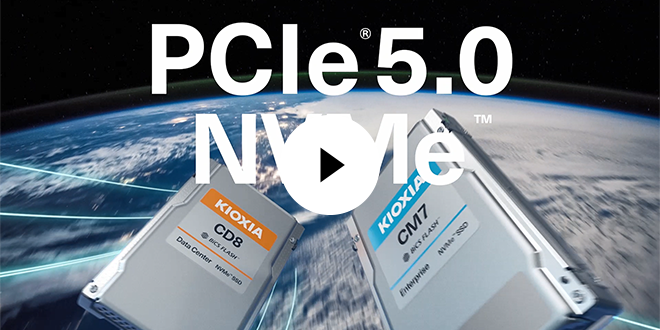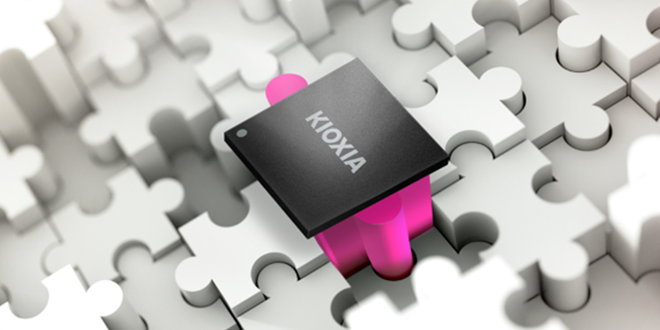Please select your location and preferred language where available.
KIOXIA SSDs History
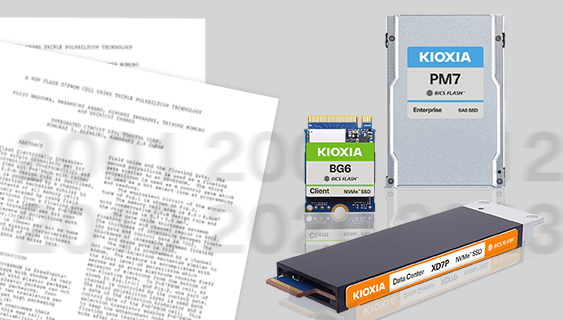
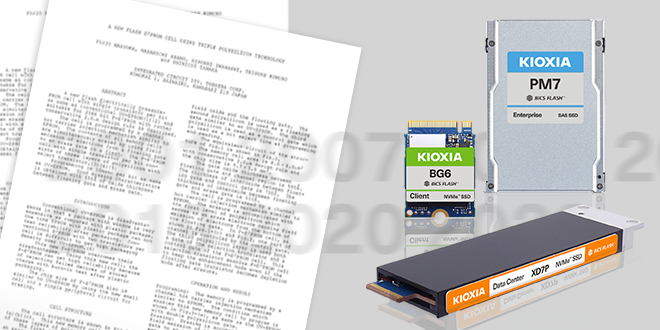
What’s KIOXIA SSDs?
SSD stands for Solid State Drive which uses flash memory as the storage medium.
KIOXIA invented the world’s first NAND flash memory in 1987. NAND flash memory is a storage device that enables large amounts of data to be stored. It is now an essential part of data centers and familiar electronic devices such as smartphones.

SSDs have advantages of high speed, low power consumption, and shock resistance compared to Hard Disk Drives (HDDs) which use magnetic disks. However, they were initially more expensive than HDDs and that puts SSDs at a disadvantage. As the cost per bit was lowered by flash memory-intensive technology, we have entered a market where we can leverage characteristics of SSDs such as faster PC boot-ups and low power consumption, and brought the benefits to the users.
SSDs are mainly composed of a controller, DRAM, and flash memory. The controller is the heart of the SSD, to control the reading and writing of data from and to the flash memory, while the DRAM is where data is temporarily stored. SSD products without DRAMs are also available by HMB (Host Memory Buffer) technology.
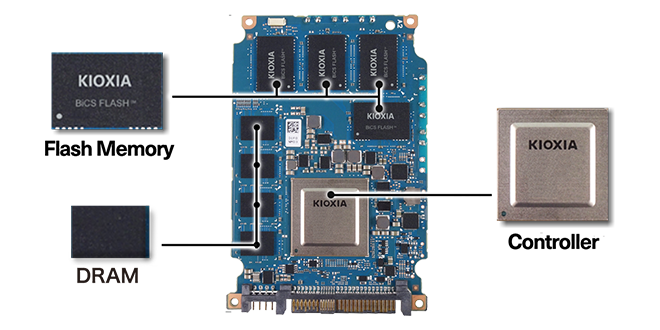
We are developing a flash memory based storage technology. Our key objective and mission is to create new markets and applications and to support various aspects of society that are only made possible with flash memory.
SSD Form Factor
Form factor is that the physical specifications and/or standards for the shape and dimensions of the housing and components of SSD, and the arrangement of connecting terminals. Different types of form factors are used in SSDs for various applications.
The 2.5-inch type form factor was the mainstream when client SSDs were first developed for its identical dimensions as HDDs. Today, thinner and smaller M.2 type SSDs have come into play as PCs have become thinner and lighter. While smaller in size, SSD capacity has increasing over the years.
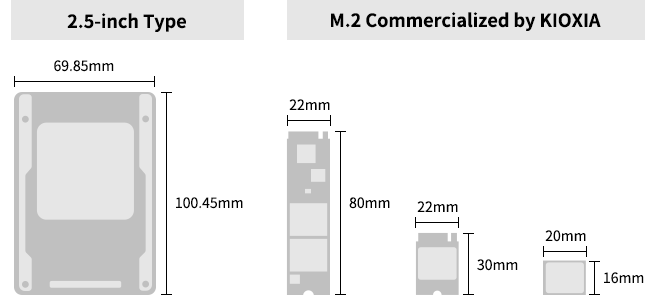

Now, the Enterprise and Datacenter Standard Form Factor (EDSFF) has becomes prominent as the next generation hyperscale, the enterprise / data centers form factor.
EDSFF is a specification developed by SNIA SFF Technology Affiliate, the standard standardizing body. Many manufacturers, including KIOXIA, are developing SSDs compliant with this standard.
KIOXIA SSD Product Line-up
KIOXIA delivers optimized SSD products and solutions for client PCs, enterprise servers and storage, and cloud data centers.
Along with the 2019 company name change, the colors of the product series have been renewed, with light blue for Enterprise SSDs, orange for Data Center SSDs, and light green for Client SSDs.
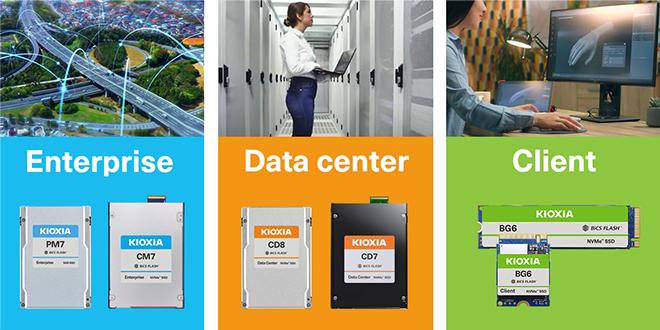
- The listed products are representative examples.
KIOXIA - SSD Products introduction movie -
KIOXIA showcases its BiCS FLASH™ 3D flash memory and family of SSDs that meet a wide range of customer needs, from personal computers to hyperscale and enterprise applications.
KIOXIA continues to enable new applications and markets that are made possible with flash memory, meeting new challenges head on!
Product Chronology
History of Client SSDs Supporting Mobile World



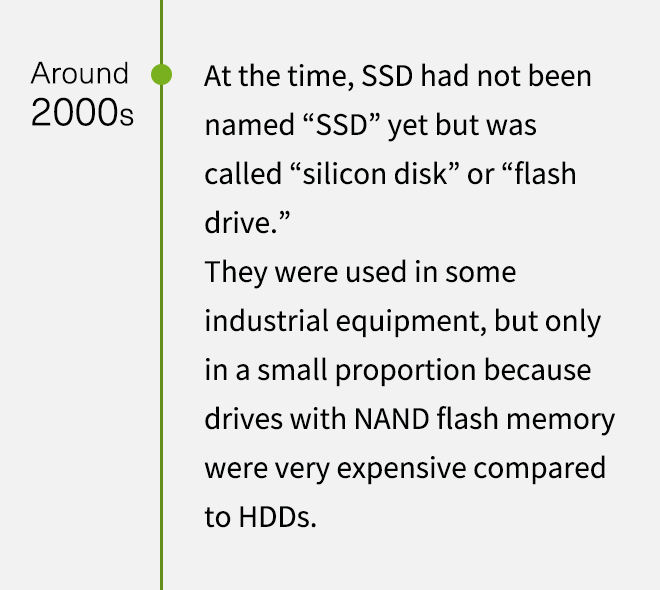

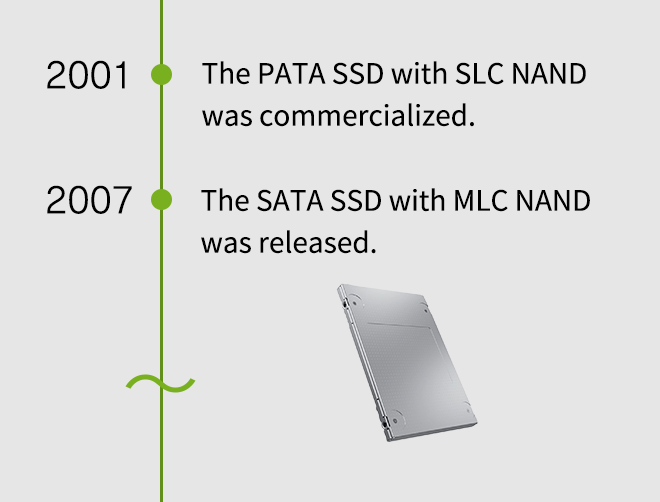


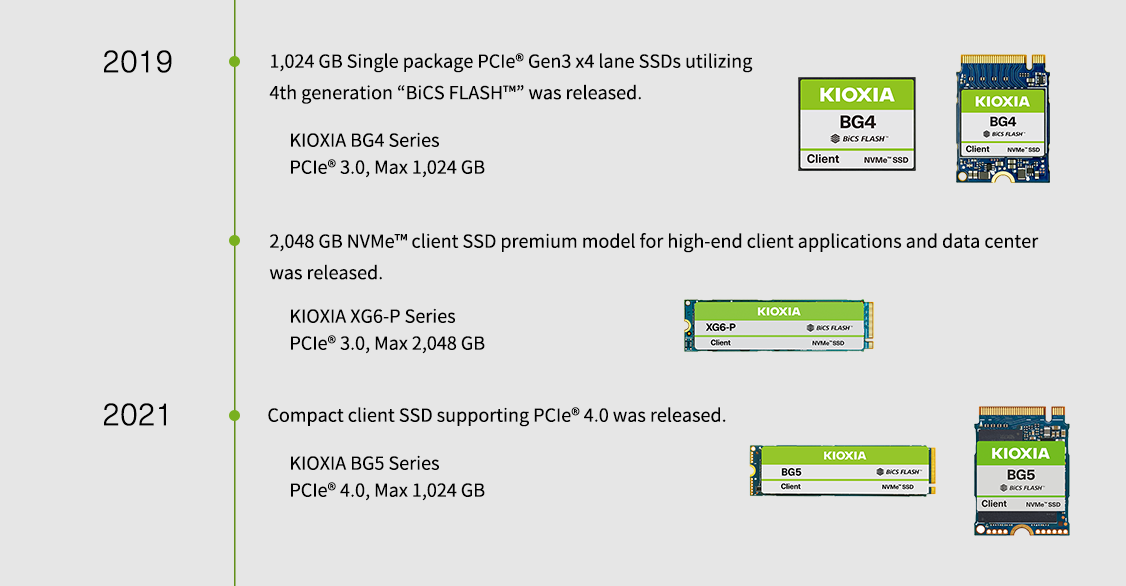
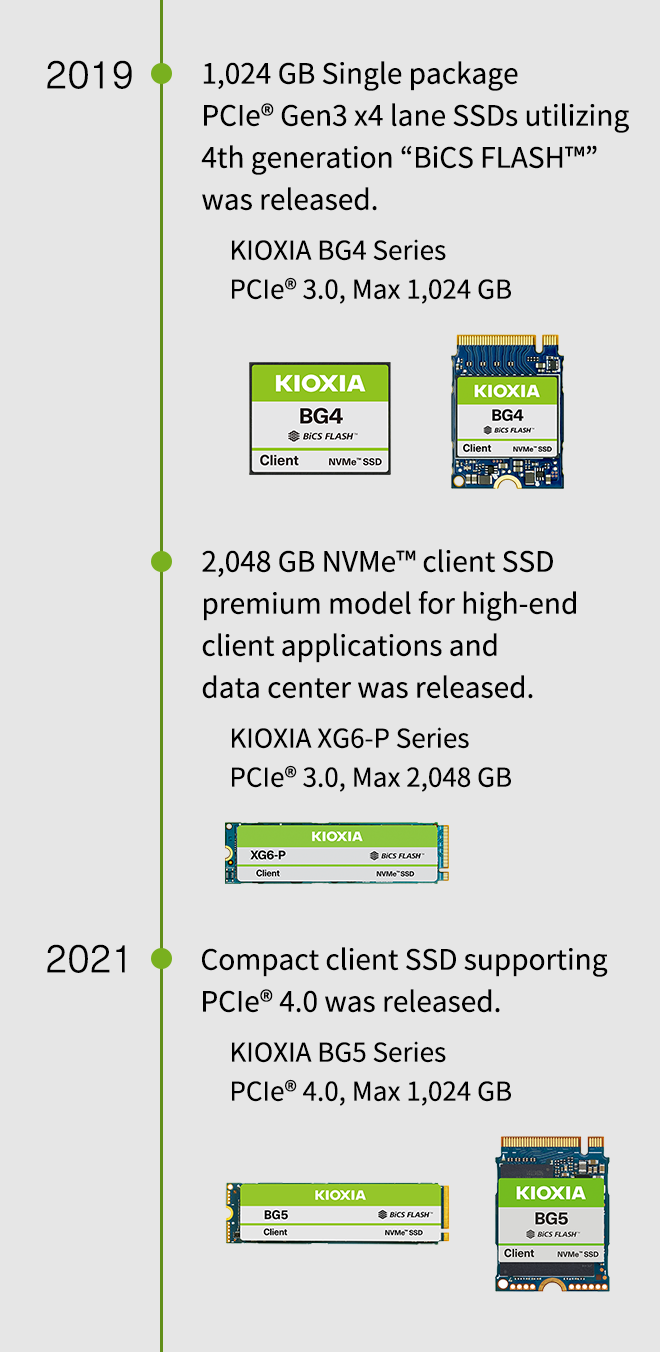
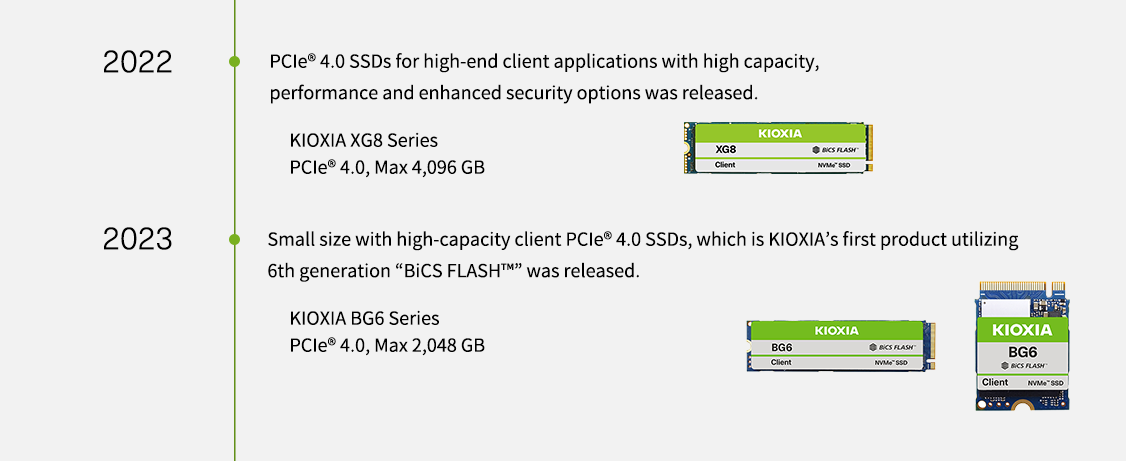
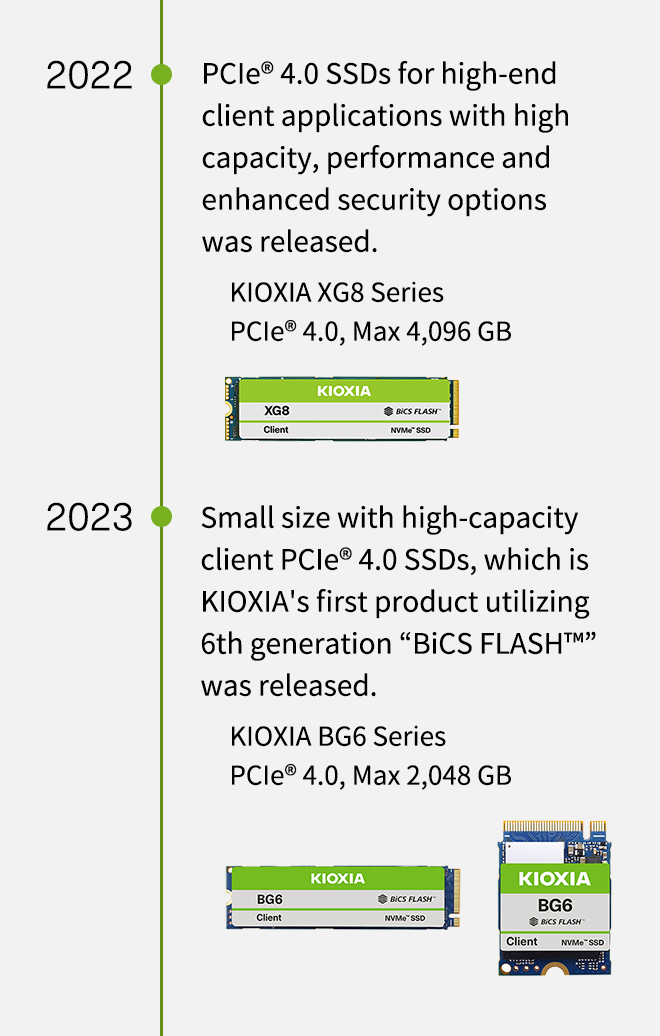
Engineer’s Voice
At the time, it was impossible to open a notebook PC and provide instant-on performance. We added this feature, even though it wasn’t a customer requirement, allowing PC to boot very quickly using SSD. It was so well received that a customer offered to develop a specialized notebook PC design leveraging SSD technology, which led to the breakthrough of KIOXIA SSD.
KIOXIA’s Client SSDs have driven the migration of HDDs to SSDs, which has benefited the commercialization of thin and light notebooks with higher performance.

History of Enterprise / Data Center SSDs Supporting Mission-Critical Systems

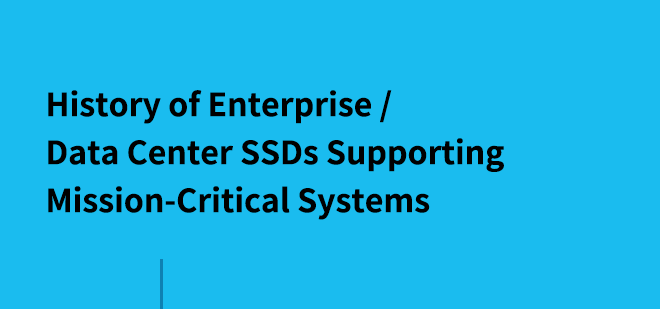

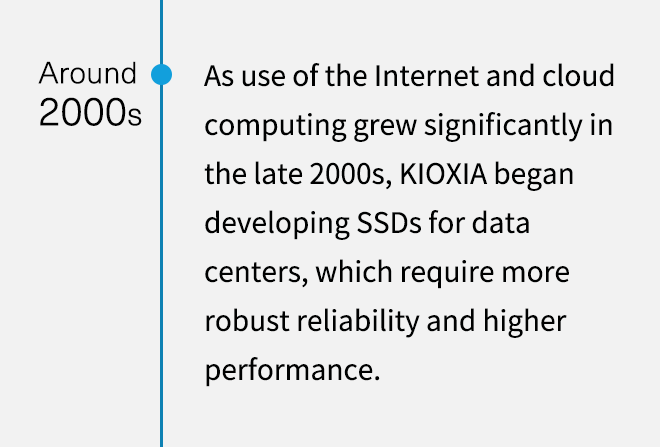
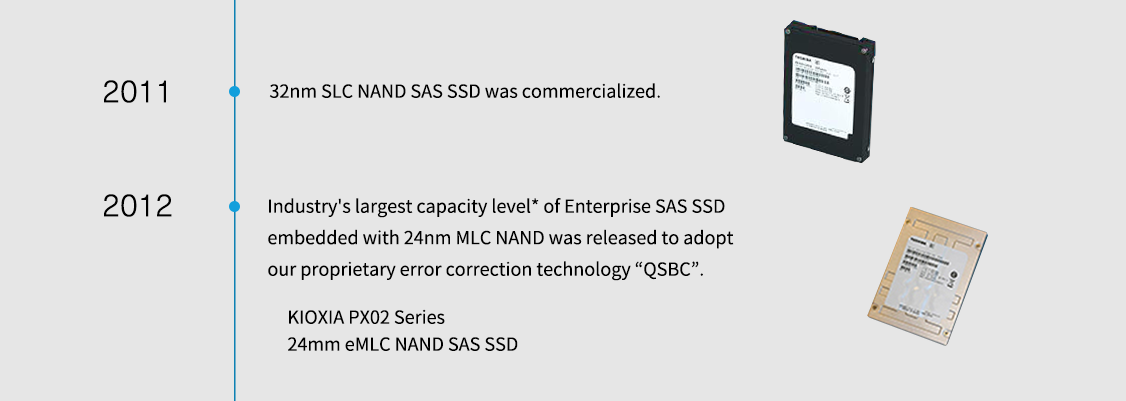
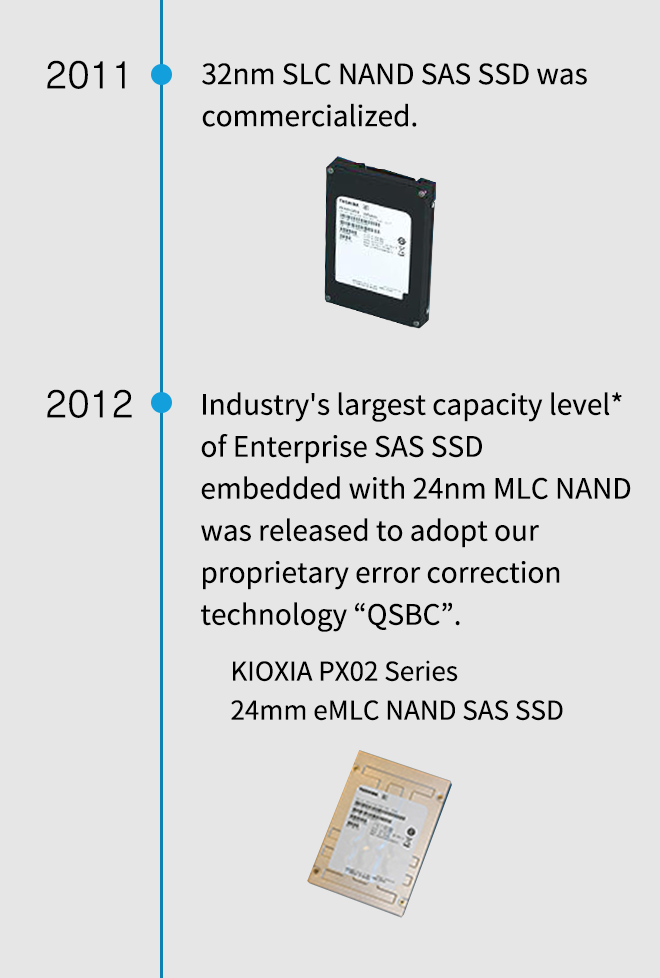
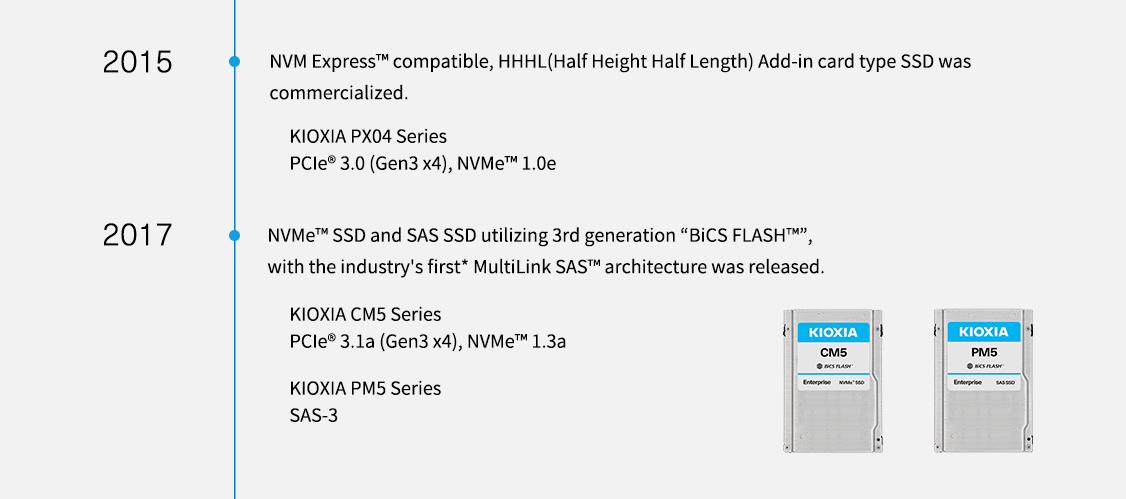
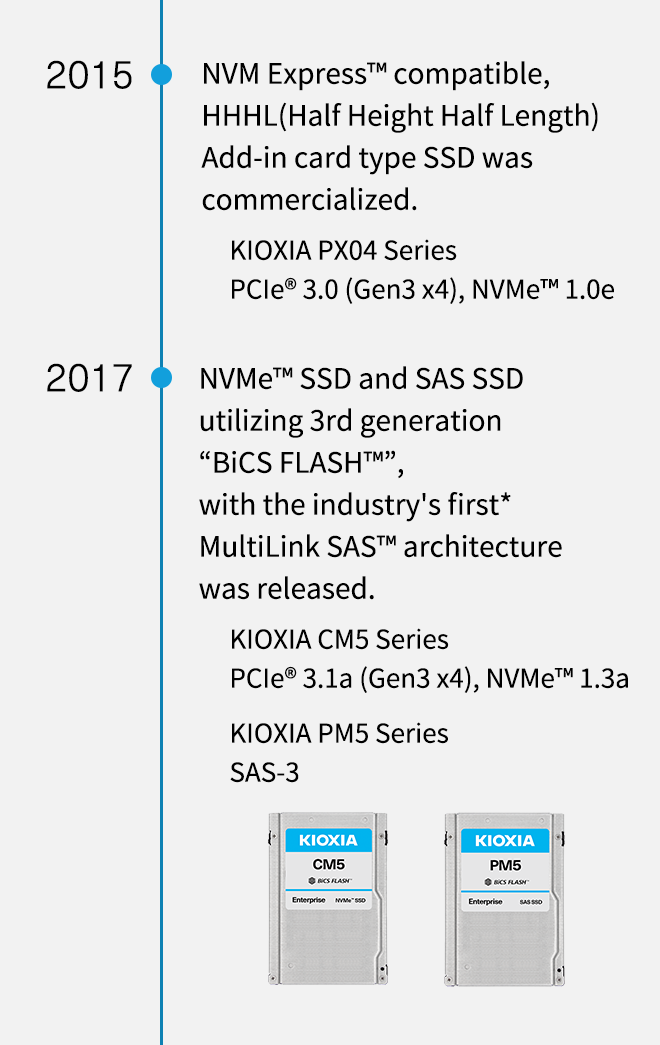
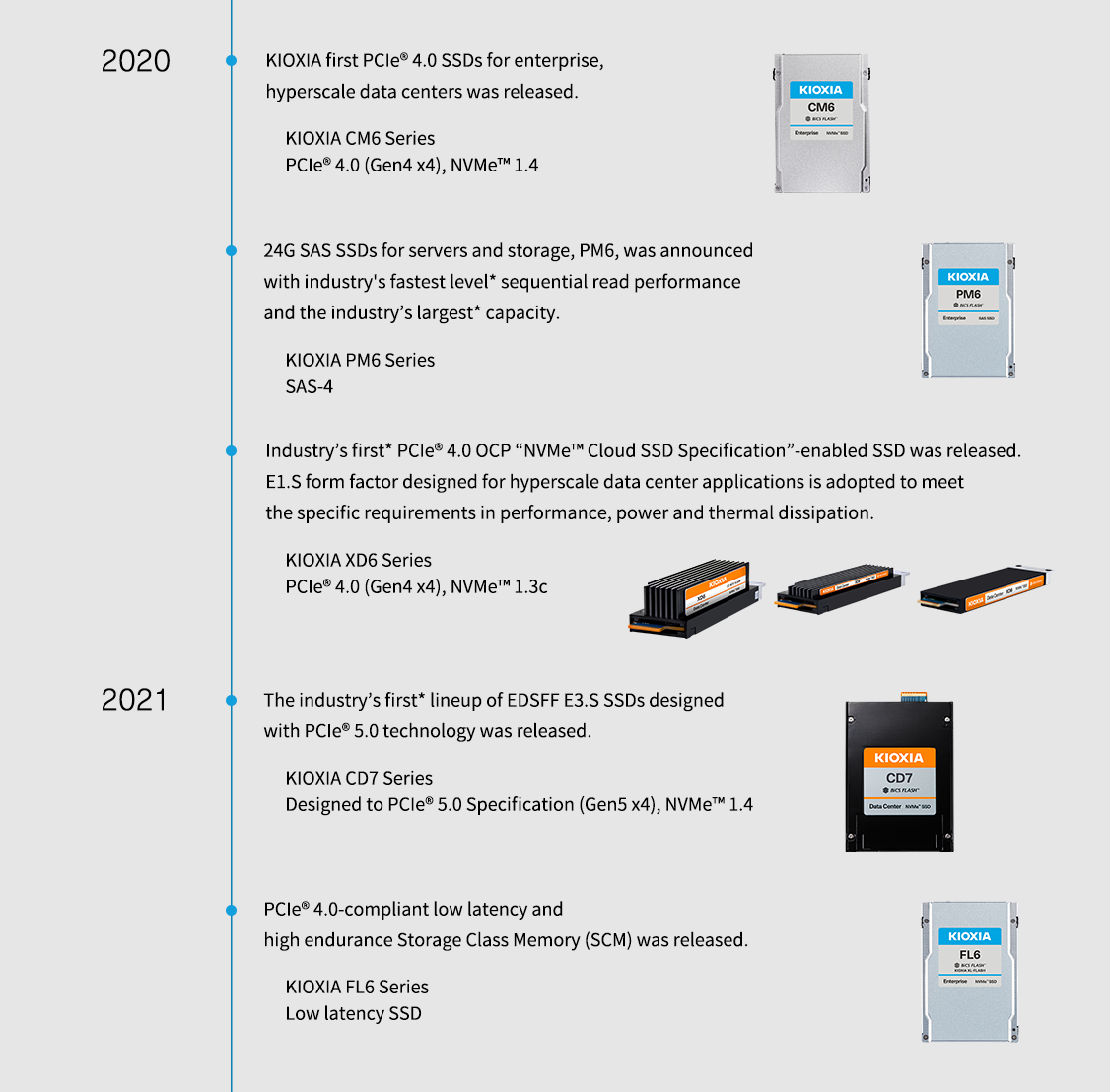

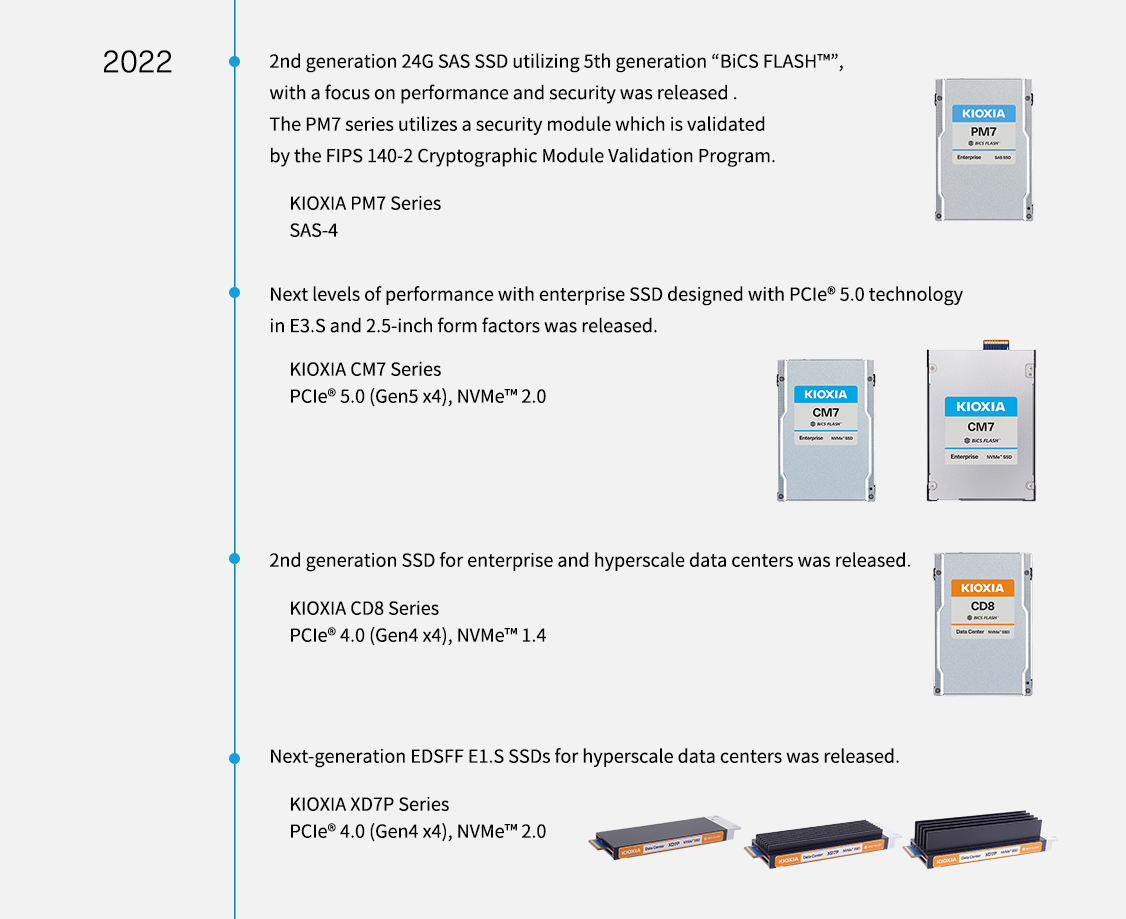

Engineer’s Voice
We wondered if customers would buy our SSDs, and if this would lead to real business opportunities. We knew the market was there and we had an opportunity, but we were still uncertain as we began our exploration efforts.
As use of the Internet and cloud computing grew significantly and expectation of potential demand and market growth in the enterprise storage and server markets, KIOXIA began full-scale development of SSDs for enterprises and data centers, in addition to client SSDs. SSD interfaces are evolving to further increase performance.


The market changes extremely fast. I joined KIOXIA in 2015. At that time, our maximum SSD capacity was 4TB. In just six years, SSD capacity has increased to over 30TB.
“Just look at this! Isn’t it amazing?” Our deepest desire is to truly develop solutions that meet the needs of our valued customers and make them happy. Creating products that help our customers realize their goals and solve challenges is incredibly exciting and rewarding for us.”
KIOXIA is developing enterprise and data center SSDs to meet next-generation server requirements for processing complex workloads such as distributed processing and edge computing in data centers at high speed and low latency.
Latest Technology & Challenge
KIOXIA introduces our latest cutting-edge SSD technologies and solutions to address the ever-increasing data volumes being generated and our commitment to the sustainable and green future.

EDSFF aims to address the issues and limitations enterprise and data center users face with legacy form factors by designing a new specification meant for NAND flash memory and other devices.
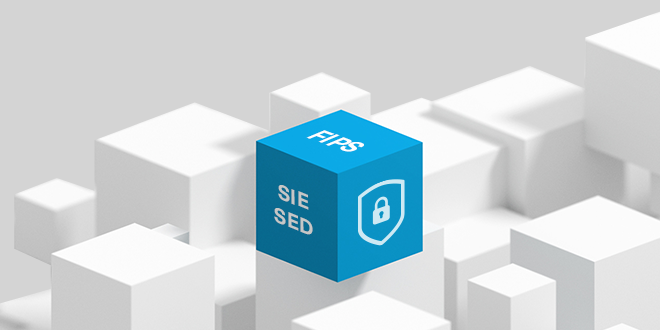
SSD security is critical to safeguard business and customer data. KIOXIA offers SSDs with a range of security functions and encryption options for various requirements, including sanitize instant erase (SIE), self-encrypting drives (SED) and FIPS validation.
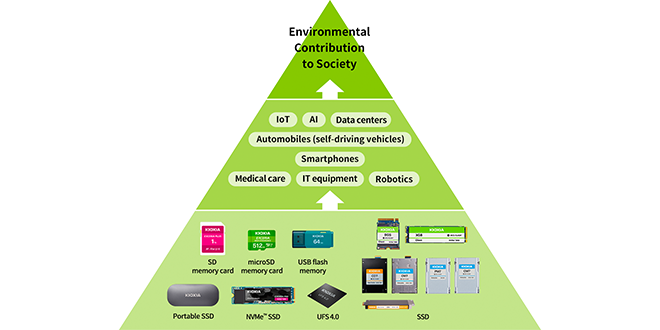
We are making efforts to reduce the environmental impact of our products throughout all stages of their lifecycles; this includes appropriate management of chemical substances used in their manufacture and ensuring the products themselves consume as little energy as possible when in use.
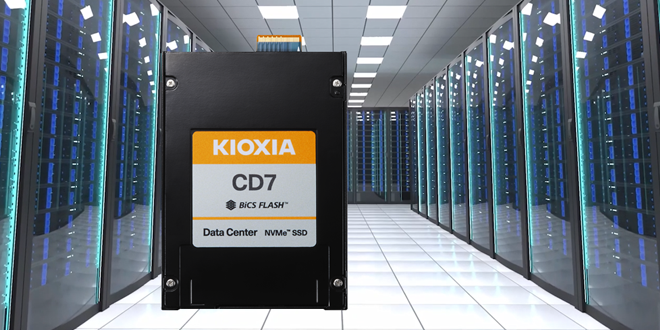
Introducing the KIOXIA and NTT Communications collaboration regarding KIOXIA's SSD products for a sustainable and green future.
- The information on this page is current as of the date of the announcement.
- Definition of capacity: KIOXIA Corporation defines a megabyte (MB) as 1,000,000 bytes, a gigabyte (GB) as 1,000,000,000 bytes and a terabyte (TB) as 1,000,000,000,000 bytes. A computer operating system, however, reports storage capacity using powers of 2 for the definition of 1GB = 2^30 bytes = 1,073,741,824 bytes and 1TB = 2^40 bytes = 1,099,511,627,776 bytes and therefore shows less storage capacity. Available storage capacity (including examples of various media files) will vary based on file size, formatting, settings, software and operating system, and/or pre-installed software applications, or media content.
- Actual formatted capacity may vary.
- Images may differ from the actual products and services.
- NVM Express and NVMe are registered or unregistered marks of NVM Express, Inc. in the United States and other countries.
- PCIe is a registered trademark of PCI-SIG.
- MultiLink SAS is a trademark of the SCSI Trade Association.
- Other company names, product names, and service names may be trademarks of third-party companies.
- © 2023 KIOXIA Corporation. All rights reserved. Information, including product specifications, content of services, and contact information is believed to be accurate as of July, 2023, but is subject to change without prior notice. Technical and application information contained here is subject to the most recent applicable KIOXIA product specifications.
Explanation of abbreviations
- SLC: Single Level Cell
- MLC: Multi Level Cell
- TLC: Triple Level Cell
- PATA: Parallel ATA, Parallel Advanced Technology Attachment
- SATA: Serial ATA, Serial Advanced Technology Attachment
- SAS: Serial Attached SCSI (Small Computer System Interface)
